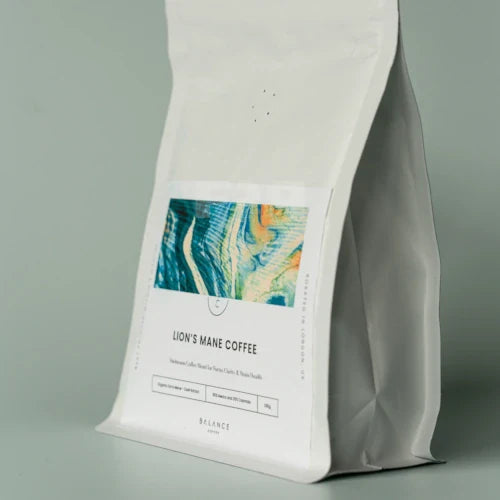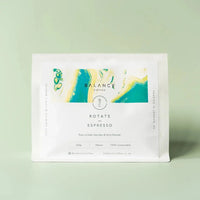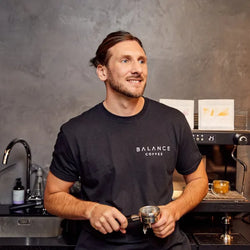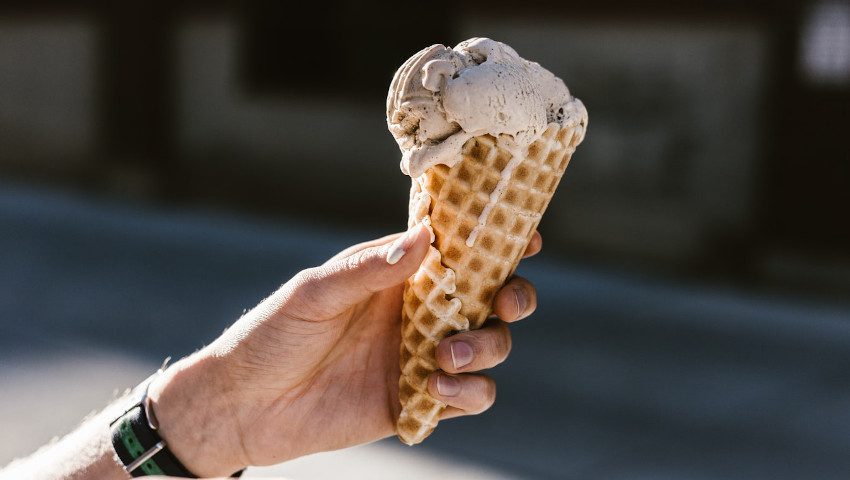We get a lot of different coffee questions, so we decided to try answering ten of your most pressing coffee FAQs!
These answers will give you lots of information - from sustainable coffee to espresso machines to latte art and more.
What's the difference between light and dark roast coffee (Coffee FAQs 1)?
You may have noticed that there are different types of roasted coffee beans, ranging from light roast to dark roast.
Other than the visual difference (dark roast beans are indeed darker in colour!), there are some key flavour differences too.
Dark roast coffee beans have been roasted longer and heated to higher temperatures.
Due to the breakdown of acids in the roasting process, they become denser and a more bitter flavour is produced.
Depending on how you like your coffee, that more bitter flavour could be a pro or a con.

In contrast, light roast coffee beans are roasted for less time, and therefore less of a bitter flavour is produced.
We generally make light to medium roast coffee beans, simply because this method retains the natural sweetness and flavours from the original raw bean.
What do I need to make great coffee at home (Coffee FAQs 2)?
There are a couple of elements that are essential to making great coffee at home!
Scales:
To brew fantastic coffee consistently, you’ll first need to measure the amount of ground coffee you are using and the water you will pour over it to make your perfect cup. This is called the coffee-to-water ratio or brew ratio, and it's extremely important for making high-quality coffee. For example, 1 gram of coffee to 18 grams of water (meaning for every unit of coffee you should use 18 units of water). You’ll never be able to get such a precise measurement if you’re not using a digital scale.
Filtered water:
The water you use to brew your coffee is also extremely important. Next time you make coffee, try using filtered water rather than regular tap water.
This is because unfiltered tap water contains minerals, many of which can negatively affect the flavour of your coffee.
Sulphates are particularly nasty because they accentuate bitterness in brewed coffee.
It’s especially important to use filtered water in the UK because some areas (London) have extremely hard water which won’t unlock the maximum flavour potential from your coffee.
Fresh coffee:
There’s a reason why small-batch, speciality coffee like ours tastes infinitely better than any you might buy in the supermarket.
This is because small-batch beans are roasted immediately before being sold.
Supermarket coffee will often sit in storage for months before being sold.
This ruins the potential flavour you would experience in the cup, because coffee is best drunk within the first few weeks after being roasted. Enjoy our freshly roasted coffee and we promise you’ll notice the difference!
What does speciality-grade mean (Coffee FAQs 3)?
As a progressive roaster focusing on quality we use the phrase 'speciality coffee' to mean coffees that have scored 80+ according to the Speciality Coffee Association and Coffee Quality Institute coffee grading standards.
We look to purchase coffees that score 82+ and in most cases 85+. From a taste point of view, there is a significant difference between a coffee that scores 80 and one that scores 85.
Generally speaking, coffees that score higher have more complexity. Another reason why we buy speciality-grade coffee is because this allows coffee producers to earn a significant premium for the high quality coffee that they produce.
Is caffeine bad for you?
Like most things, caffeine is absolutely fine if consumed in moderation. However, there are a couple of side effects if you drink too much coffee.
For example, you may have experienced a caffeine-induced energy crash. This can occur 25 minutes to a couple hours after you’ve consumed coffee or tea.
It makes you feel extremely tired and sleepy, irritable, and unable to concentrate. Sometimes it can even feel a bit like a hangover due to nausea and headaches.
We have a blog post about how to avoid coffee-induced energy crashes if this is something that you'd like to stop experiencing.
We also have a great blog post about caffeine, covering its potential effects and how best to avoid them.
What's the best espresso machine to buy (Coffee FAQs 4)?
First of all, you need to think about your budget. How much are you looking to spend on your new home espresso coffee machine?
This goes beyond the price of the espresso machine itself, as it also includes anything you may need to buy on top.
For example, if your new espresso machine does not come with a built-in grinder, and you don’t already have a good one, you will also need to add the cost of a grinder to your budget.
Another incredibly important aspect of buying an espresso machine for your home is ensuring that the quality is top-notch.
For that reason, we recommend the range of Sage home espresso machines. Not only are these espresso machines beloved by home baristas, but they also come with a two-year warranty.
They’re made from extremely high-quality stainless steel, which makes them even better!
Espresso coffee machines made from metal are more durable, lasting longer and retaining heat much more efficiently, which is important for making great coffee time after time.
If you have a rough idea of your budget and the brand you want to purchase, you should next think about the space available to you in your kitchen or coffee-brewing space.
Espresso machines can be pretty large and heavy, even ones made for home baristas! Measure out the space available to you, including height, width, and depth.
Finally, it’s important to be honest about your lifestyle. Do you want to take the time every morning to froth your own milk, or even try your hand at latte art? Or would you rather have the convenience of a latte at the push of a button? Don’t just think about the coffee-making, but also how easy the machine will be to clean.
To learn more about espresso machine maintenance, head to our blog about it!) If you know that you’re not going to put in the time (and money) to clean a high-end espresso machine properly, then it’s probably best that you get something a bit simpler.
What is a coffee subscription (Coffee FAQs 5)?
To put it simply: a coffee subscription service is coffee delivered straight to your door with no fuss!
Our coffee subscription service is designed to remove the hassle of reordering coffee.
Select your preferences, including the frequency of your subscription, and we’ll automate the rest by taking payment and delivering coffee to your doorstep.
There are so many reasons why a coffee subscription service is the perfect way to drink coffee at home. Here are some of our personal favourites:
- Convenience – We cannot overstate how convenient a coffee subscription is! Creating your subscription takes less than five minutes, and you can receive speciality-grade coffee on autopilot from there! It really takes the hassle out of re-ordering coffee.
- Flexibility – We are also extremely flexible! If you’ve invested in a great coffee grinder, you can log into your account and change your subscription from ground coffee to whole beans. If you happen to be travelling, you can skip a month or adjust how often you want your coffee to arrive.
- Exploring the world of coffee – We know it can sometimes be difficult to choose what coffee you want to try next, especially when there are so many delicious options available! With our coffee subscription service, we do the choosing for you so you can try a wide variety of flavours.
What does single origin mean?
Single-origin coffees are coffees from a particular region, farm or area within a farm.
One reason why you may prefer to drink a single-origin coffee is that they are great at highlighting the unique flavours of a particular country or region. They’re similar to wine in that way.
For example, Zimbabwean coffee tends to be medium-bodied with citrusy acidity and a woody and sweet flavour.
Whereas coffee from Nicaragua has balanced sweetness with notes of chocolate and florals.
If you really want to experience a country’s coffee in all of its glory, you’ll want to buy single origin coffee beans to taste it for its unique characteristics inherent to its location.
How do I know if a coffee is sustainable?
Generally speaking, we define ‘ethical coffee’ as coffee that has been bought directly from farmers at a fair price.
By fair, we mean a price that covers the cost of production and includes a healthy margin for the farmer.
Ethical coffee is farmed in a way that respects the environment for future generations and promotes biodiversity.
This may include coffee that has been organically grown (although we recognise that not all coffee producers will be able to afford an organic certification).

If you’re going to buy coffee at a coffee shop, we always recommend going to local independent businesses rather than large chains.
Small, independent coffee shops are more likely to have direct relationships with roasteries and coffee farms.
They’re also more likely to answer any of your questions about where they source their beans. In terms of buying your own coffee beans, we recommend sources that are transparent about their ethical policies.
Look at the coffee company’s website – do they have a dedicated page where they discuss their sustainable and ethical policies?
Much like smaller coffee shops, smaller coffee roasteries are more likely to be involved with their supply chains and the farms their beans come from, and they’ll usually be able to answer questions about the farms they work with.
What coffee should I choose?
This is a very difficult question to answer! It’s really down to you and your coffee preferences.
If you’re interested in experimenting with single-origin coffees, we recommend looking closely at the flavour notes before you buy them.
If you know that you like chocolate-y, fudge-y flavours, then try coffees which have those flavours. You also need to think about what will work best with your brewing method of choice.
Lightly roasted single-origin beans work particularly well in filter coffees because they have more subtle flavours to be extracted.
You can get the best flavours out of a single-origin coffee by brewing it with something like a Hario V60 or a Chemex.
Whereas using a single origin for espresso can be tricky because they are less versatile, and because they can get lost if you serve them in a milky drink such as a latte.
If you're really stuck, then why not try our coffee subscription? We'll do the choosing for you!
How do I do latte art?
First, you'll need to master the art of steaming milk. Then you should begin with a basic design.
Pour an espresso into the bottom of a round cup, and then add a small amount of steamed milk.
Swirl the espresso and milk together. Pour more of your milk slowly and evenly from a fairly high position, and then move the milk closer to the cup as you finish.
Here’s a video of our founder, James, creating some gorgeous latte art.
Did we answer all of your coffee FAQs?
We have lots of information about coffee, coffee equipment or particular techniques on our blog, and we're happy to answer any of your questions on our Instagram!














